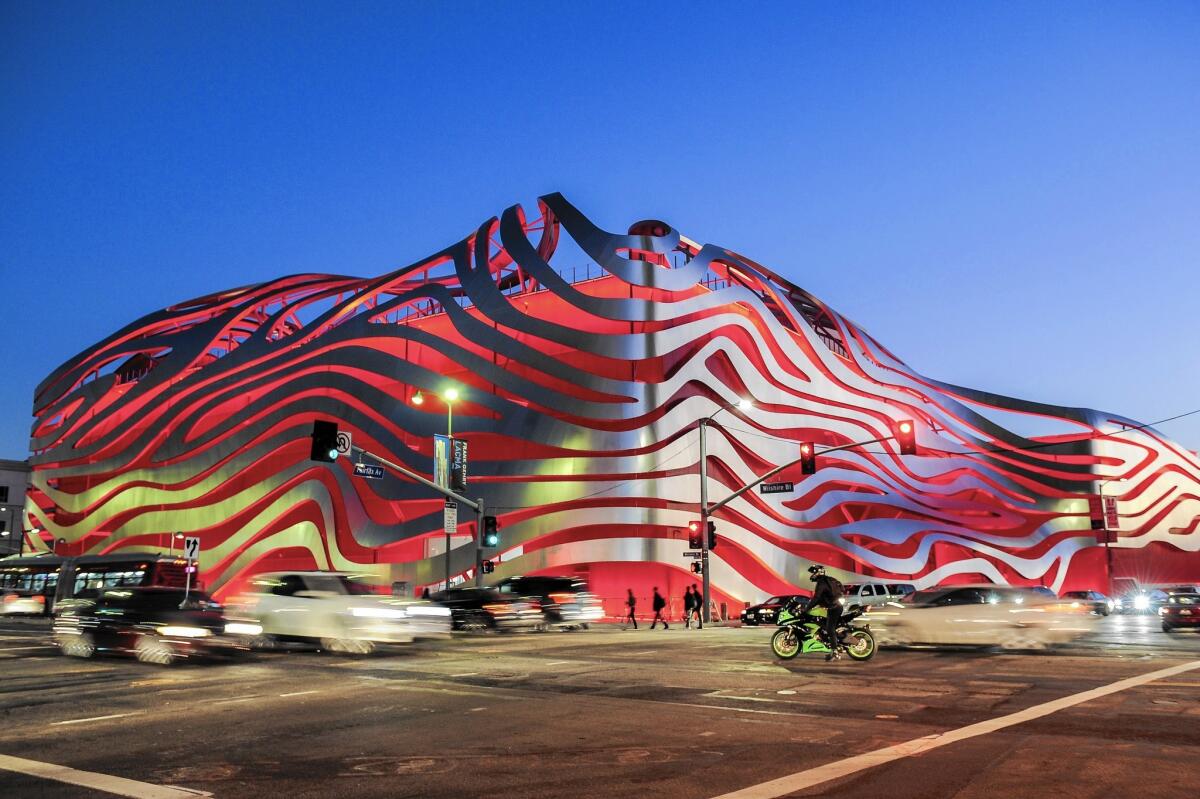For architecture in 2015, the world’s ‘soft targets’ prompt a reevaluation

- Share via
High-profile architecture continued to find its footing in 2015, to reassert itself after the fallow years of the recession. Big-ticket buildings are once again coming in a rush. This year we saw the opening of the Broad museum in downtown Los Angeles (by Diller Scofidio + Renfro), the remodeled Petersen Automotive Museum on Wilshire Boulevard (by Kohn Pedersen Fox) and the new Whitney Museum on the far West Side of Manhattan (by Renzo Piano).
Next year will bring the remade San Francisco Museum of Modern Art (by Snohetta), the Smithsonian’s National Museum of African American History and Culture (by David Adjaye and Philip G. Freelon) and a clutch of other important designs, as well as an announcement about where in Chicago President Barack Obama plans to locate his presidential library and archive.
But it is hard to summon the same sense of urgency about buildings like that as we once did. Sure, the Petersen is aggressively bad, an example of New York architects conjuring some dated and ultimately lazy idea of what Los Angeles means — and then forcing Los Angeles to live with the result.
READ MORE: Who will design Obama’s library? Key questions in architecture as 2015 wraps up
Yet in the face of mushrooming homeless encampments and grainy videos of police shootings, that kind of architectural excess seems more comically misguided than offensive. In the face of the Bataclan and San Bernardino it seems practically meaningless.
Not that architecture hasn’t produced compelling efforts to close the gap between a building like the Petersen and the real world, between a cartoonishly tumultuous facade and actual tumult. This year’s Turner Prize, a much analyzed honor in contemporary art, went to Assemble, a young London-based collective that sees its work as a combination of art, architecture and political engagement and has helped bring vacant Victorian row houses and other abandoned buildings back to life.
In October the first Chicago Architecture Biennial made its debut with a similarly broad-based agenda. Its curators, Sarah Herda and Joseph Grima, went out of their way to stitch connections between the show and the city of Chicago — and between the profession and issues such as police shootings and inequality. The exhibition was thoughtful about racial politics, the specter of climate change and the perils of urbanization.
And yet it was somehow not enough. Or maybe it’s better to say that the show, for all its intelligence, merely illuminated the size and the depth of that gap. After all, during the three days I spent in Chicago covering the opening of the biennial, the most striking image I saw was not part of the exhibition.
It was a sticker, visible on storefronts across the city, showing a handgun with a red circle around it and a red line through it. In the corner, in small type, were the words “Pursuant to 430 ILCS 66/65,” a reference to the Illinois state law that prohibits concealed weapons in certain buildings, including schools, day-care centers and museums.
To the extent that the overlap among guns, violence and the contemporary city is in some small part an architecture story — and I believe strongly that it is — it’s not at all clear what the response from architects, critics and curators of exhibitions like the biennial ought to be. The point is not that Herda and Grima should somehow have anticipated the bloodiness of the weeks that followed the opening of their wide-ranging show. The point is not that buildings need to be more thickly armored, or that every corner of every quasi-public space needs armed guards. It’s not about memorials and rebuilding.
It is simply that the phrase “soft target,” an architectural phrase if there’s ever been one, has come, in all sorts of horrific ways, to define the year. In 2001 the images that terrified us were of skyscrapers on fire and then collapsing. In 2015 the pictures showed a different, more tragically mundane kind of architecture: a multipurpose room set up to hold a holiday party, a nightclub, a cafe, a restaurant — the kind of place that might carry a red sticker on the door, and that this time last year we might have walked by, or into, without a second thought.
ALSO
Book Critic David L. Ulin’s top 10 books of 2015
‘Brooklyn’ tops Kenneth Turan’s best films of 2015
‘Game of Thrones,’ ‘Gotham,’ ‘Parks and Rec’ and ‘Transparent’ among 2015’s best TV shows
More to Read
The biggest entertainment stories
Get our big stories about Hollywood, film, television, music, arts, culture and more right in your inbox as soon as they publish.
You may occasionally receive promotional content from the Los Angeles Times.











